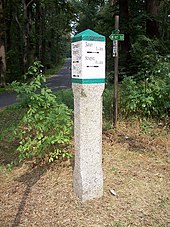Signpost

A signpost column , also called a way column or way column , is a historical form of the signpost . These pillars were made of stone and showed the traveler the way for decades. Signposts are classified as minor monuments and are often already included in the respective monument protection lists.
Signpost pillars are often smaller than other stone waymarks or can only be distinguished from them by their shape. They stand as historical Wegzeugen in a row with post mile pillar , post or road - milestones , Chaussee- or road maintenance stones , hall or district columns , signposts or ™ stones and landmarks .
Saxony
In addition to the state-ordered postal columns, municipal signposts were later established. According to the ordinance of the Saxon state government regarding the erection of signposts and place-name signs from January 29, 1820, which was valid until 1934, the municipalities erected signpost pillars first in wood (like the already known arm pillars ) and later in stone. Ordinances of February 28, 1820 and August 29, 1820 are also mentioned.
In Saxony square shapes were / are very common, round columns or other converted columns are in the minority.
The research group Kursächsische Postmeilensäulen eV regards the circular signposts as a transition form between the wooden arm pillars and the communal signpost pillars or from the Kursächsische Postmeile pillars to the Royal Saxon milestones , which "only occur very rarely".
Distance information was often given in the official journeys from 1721–1840 (1 hour / hour = 4.531 km); from around 1900 onwards in kilometers (km). Both details were seldom found on the column. Columns without distance information are also known. Occasionally the place name of the location, for example with the designation "Commun" for municipality, and the year of construction / production were given. The material was usually local sandstone, granite or porphyry in a typical regional design.
In 1840 the length units were adjusted to the "small mile" due to the postal tax regulations. The mile was thus shortened from 9.062 kilometers to 7.5 kilometers, so that the z. Some of the Saxon post-mile pillars that were still in existence were no longer usable and visibly fell into disrepair. The signposts, however, did not necessarily have distance information, so they could still be used. In the course of the decades these stone witnesses were no longer needed, damaged or removed due to road reconstruction, expansion or even relocation. They have also been replaced by new and improved signposts.
See also
- Post mile pillars
- Saxon postal mileage pillar
- Gallery of the Saxon post mile pillars
- Gallery of the royal Saxon milestones
- Gallery of signposts in Saxony
literature
- Collective of authors (head of Eberhard Stimmel): Lexicon Kursächsische Postmeilensäulen , Transpress VEB Verlag for Transport, Berlin 1989, ISBN 3-344-00264-3 .
- René Prokoph: Stone signpost pillars in the Saxon Switzerland district , series of publications by the Pirna City Museum, issue 10, Pirna 1997.
- Post pillars and milestones . Published by the research group Kursächsische Postmeilensäulen e. V. Dresden / Grillenburg (City of Tharandt). 3rd revised edition, Schütze-Engler-Weber Verlag GbR, Dresden 2007, ISBN 978-3-936203-09-7 .
Web links
Individual evidence
- ↑ Joachim Seyffart: On the way on old roads: From 1820 new signs point the way. In: Erzgebirgische Heimatblätter , issue 1/2015, page 3.

